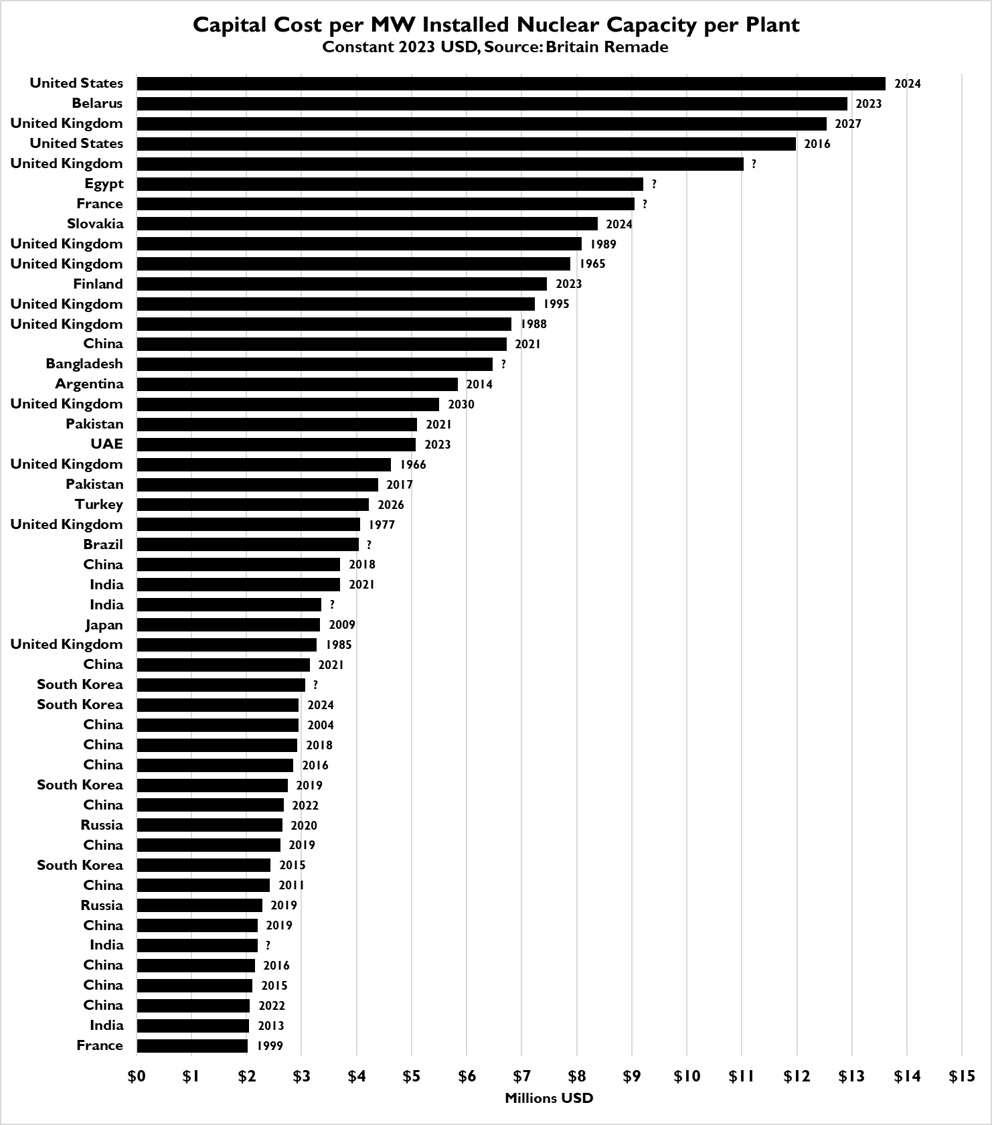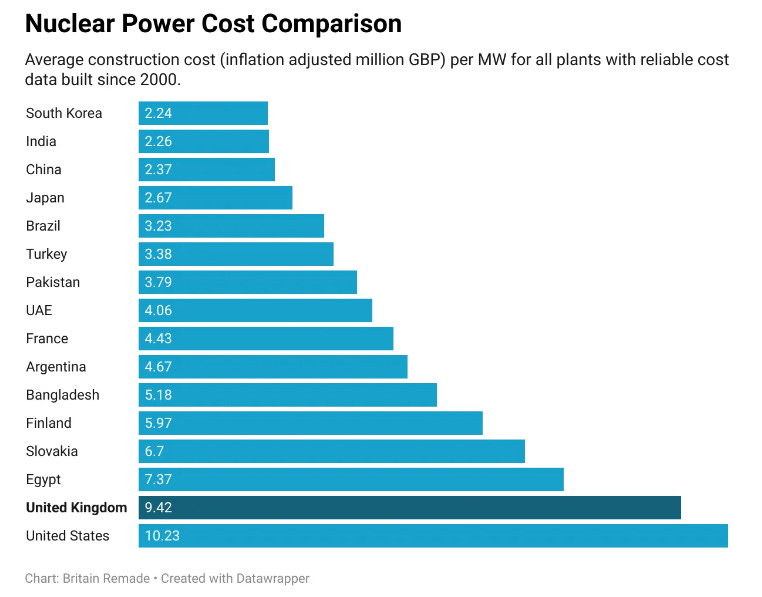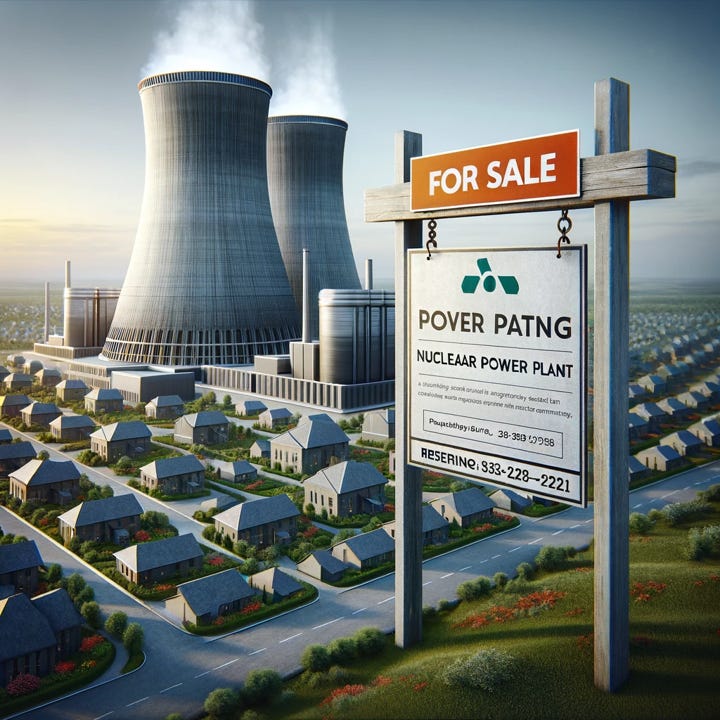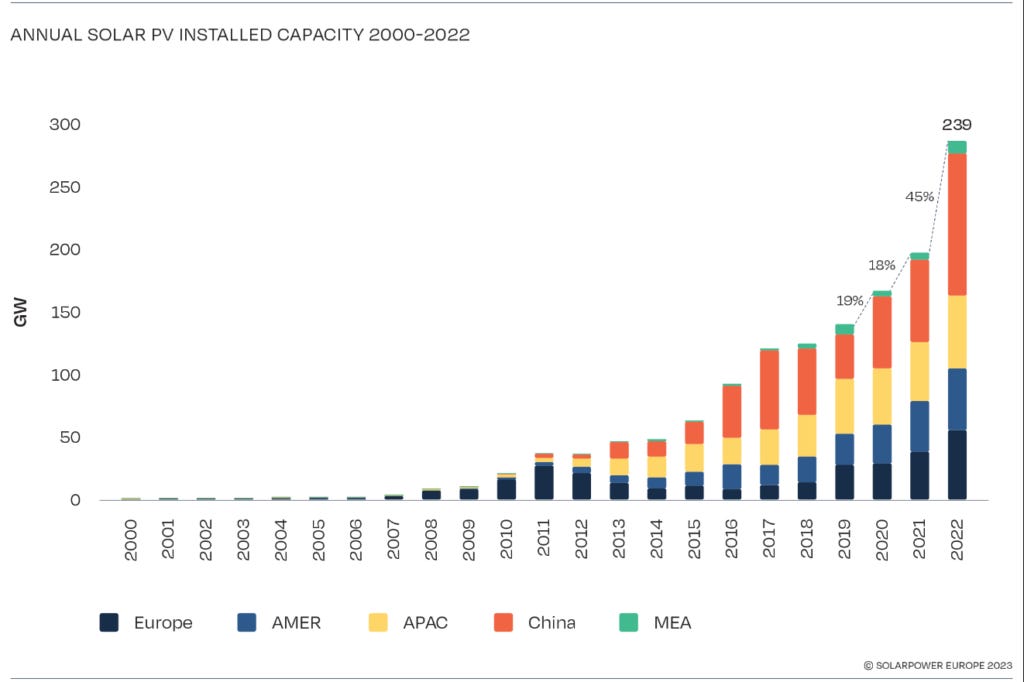How Much Does it Cost to Build a Nuclear Power Plant?
Probably a lot less than you think
A new database just released by Britain Remade presents the capital costs of 49 nuclear power plants, of which 39 were completed since 2000.1 You can see the costs per megawatt (MW) of installed capacity in the table below. Each bar refers to an individual power plant, and is annotated with the year of completion.

The costs span a very large range, from $2.03 million per MW to $13.61 million per MW. Britain Remade also averages the costs-per-plant for post-2000 completions by country, which you can see below, expressed in Great Britain Pounds (multiply by 1.25 to convert to U.S. dollars). South Korea, India, China and Japan come in with the lowest costs. The UK and US bring up the rear.

Writing at Bloomberg yesterday, Jonathan Ford had a lengthy look at building nuclear power plants, with a focus on the U.S. company Westinghouse and the challenges it faces even as nuclear power comes back into favor.
Ford writes that for Westinghouse, a renewed focus on nuclear:
. . . opens dizzying visions: a way back from perdition to the front rank of nuclear suppliers in a reinvigorated industry. As one of the few Western companies with all the pieces in place — a reactor licensed and ready to sell with examples already in operation, and a big fuel-making business — it is critical to the West’s efforts not just to rebuild its nuclear infrastructure, but also to deprive Russia of a vital source of power and income and to strengthen the transatlantic alliance.
Yet Westinghouse is very far from turning this dream into reality. Its recovery is lopsided and confined largely to the servicing business. That bustle and optimism have yet to transfer to the new reactor side — and for deep-seated reasons. Years of inertia have denuded the company of capital, skills and willing customers. While rhetorically committed to building new nuclear plants, policymakers in Washington have yet to grasp the sheer difficulty of getting reactor construction moving domestically. That will require a wholesale reboot of the compact between the state and industry — what you might call the nuclear-industrial complex. Without it, Westinghouse will continue firing solely on one cylinder, and the odds of America, and the West, missing its climate targets will soar.
Ford explains that building nuclear plants as one-offs leads to much higher costs:
. . . “first of a kind” nuclear plants rarely go up without some hitch. Reactors are, after all, complex beasts, and contractors have to learn the hard way how to build them. The payback only comes when those clued-up workers build fleets of similar units, perfecting the supply chain that allows for consistent delivery and more efficient techniques. (In a recent paper, the US Department of Energy estimated it might take “10 to 20 reactors” for the optimal point to be reached, with each successive unit before then costing steadily less.) It is why South Korea, having built programmatically since the 1980s, can throw units up for $2,000-4,000 per kilowatt of capacity, against close to $10,000 for Vogtle 3 [in Georgia].
The recent DOE report referenced by Ford suggests that it will take building as many as 20 identical nuclear power plants to fully understand how much it actually costs to build a nuclear power plant, which they project might be as low as $3.6 million per MW:
To unlock deployment at scale, Nth-of-a-kind (NOAK) advanced nuclear overnight capital costs may need to approach ~$3,600 per kW. While the estimated first of a kind (FOAK) cost of a well-executed nuclear construction project is ~$6,200 per kW, recent nuclear construction projects in the U.S. have had overnight capital costs over $10,000 per kW. Delivering FOAK projects without cost overrun would require investment in extensive upfront planning to ensure the lessons learned from recent nuclear project overruns are incorporated. Subsequent nuclear projects would be expected to come down the cost curve to ~$3,600 per kW after 10-20 deployments depending on learning rate; this cost reduction would largely be driven by workforce learnings and industrial base scale-up.
This creates an interesting paradox, which at times is wielded disingenuously by anti-nuclear campaigners— we can’t know the costs of building nuclear power plants until we commit to actually building nuclear power plants, but opponents to nuclear claim it is too expensive based on the costs associated with building a single plant.2
As Westinghouse CEP Patrick Fragman explains:
“You do well what you do often. If you asked GM or BMW to build a car every 20 years it will for sure be very expensive and take much longer than you expected.”
Solar also was once very expensive, and much has been made about the incredible lowering of the costs of solar in recent years. However, cost reductions did not happen by magic, but through deployment and learning, as you can see below.3
At COP28, 22 countries have pledged to triple nuclear capacity by 2050. That implies a global increase of about 800 GW of installed capacity, or about 30 GW per year to 2050.
According to Thunder Said Energy:
Adding 30GW pa of new nuclear capacity per year would be a massive escalation from, as the world has only added around 6 GW per year of new capacity in the past decade.
However, there is precedent, as the world installed 25-30 GW pa of new nuclear reactors at peak, during the mid-1980s, and after a wave of project-sanctioning that followed major energy crises in 1973-74 and 1979-80.
Tripling nuclear energy is doable, because that rate of deployment has been done before.
So how much does a nuclear power plant cost?
With the world finally again getting serious about nuclear, it looks like we are going to find out. As with solar and wind, I suggest taking the under.
Thanks for reading, liking and sharing! I welcome you comments and critique. THB is a reader supported effort, and I invite your support.
The other 10 plants in the database are British nuclear power plants.
It is perfectly fair for people to fear nuclear — people array their values around all energy technologies. However, it is difficult reconciling demands for net-zero carbon dioxide with an anti-nuclear stance. I’d like to see technological magic occur as well, but it is not a great basis for real-world policy.
Deployment and associated lowering of costs create a virtuous cycle. This is how innovation works.




One reason nuclear energy is so expensive in the US is unrealistic regulations. Don't see Congress or anyone else bringing common sense to the table. We had our chance sixty years ago when nuclear energy provided economical electricity but we allowed the nut-jobs to destroy our future with their campaign against the atom.
Hey y'all! I don't care if you like Lazard analysis or not. Just be friendly here. Thank you!